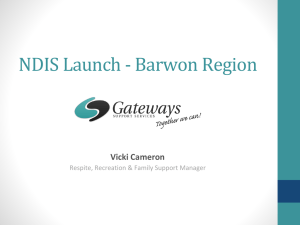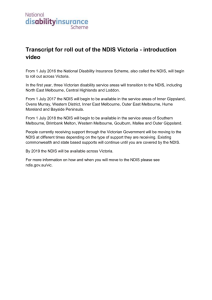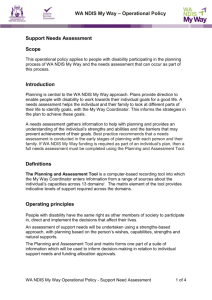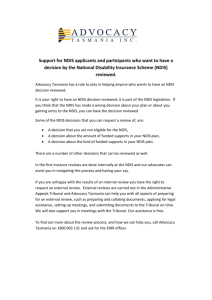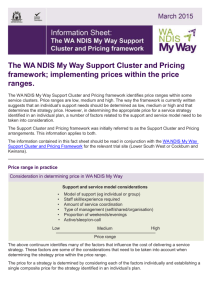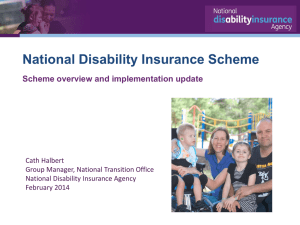NDIS Parent Checklist
advertisement
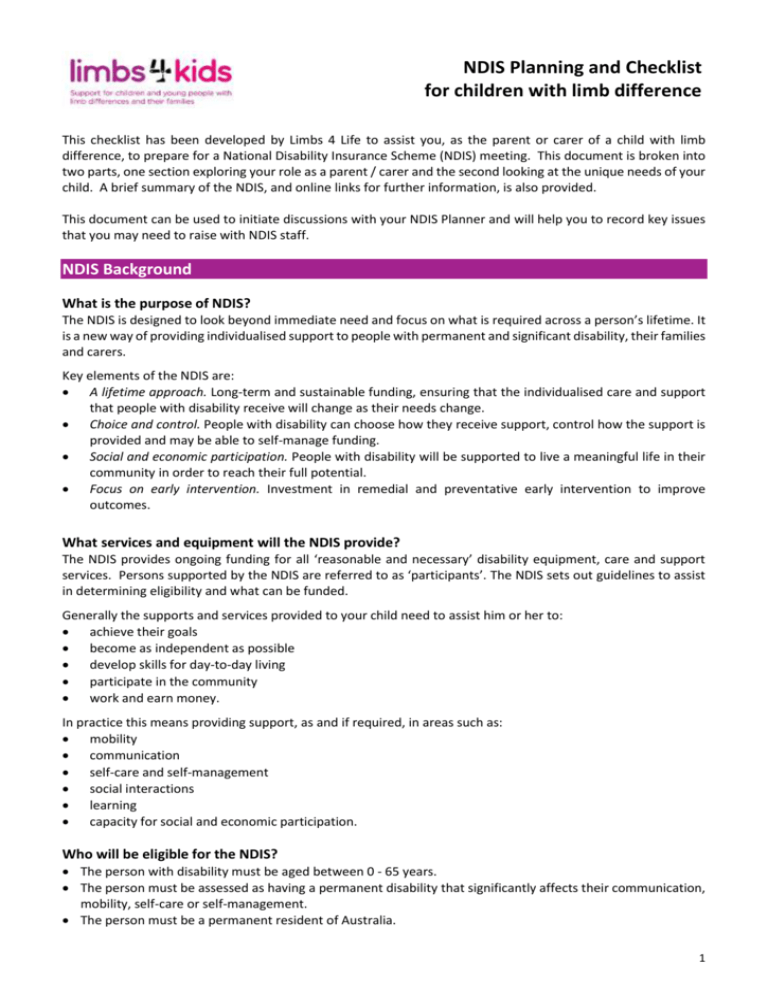
NDIS Planning and Checklist for children with limb difference This checklist has been developed by Limbs 4 Life to assist you, as the parent or carer of a child with limb difference, to prepare for a National Disability Insurance Scheme (NDIS) meeting. This document is broken into two parts, one section exploring your role as a parent / carer and the second looking at the unique needs of your child. A brief summary of the NDIS, and online links for further information, is also provided. This document can be used to initiate discussions with your NDIS Planner and will help you to record key issues that you may need to raise with NDIS staff. NDIS Background What is the purpose of NDIS? The NDIS is designed to look beyond immediate need and focus on what is required across a person’s lifetime. It is a new way of providing individualised support to people with permanent and significant disability, their families and carers. Key elements of the NDIS are: A lifetime approach. Long-term and sustainable funding, ensuring that the individualised care and support that people with disability receive will change as their needs change. Choice and control. People with disability can choose how they receive support, control how the support is provided and may be able to self-manage funding. Social and economic participation. People with disability will be supported to live a meaningful life in their community in order to reach their full potential. Focus on early intervention. Investment in remedial and preventative early intervention to improve outcomes. What services and equipment will the NDIS provide? The NDIS provides ongoing funding for all ‘reasonable and necessary’ disability equipment, care and support services. Persons supported by the NDIS are referred to as ‘participants’. The NDIS sets out guidelines to assist in determining eligibility and what can be funded. Generally the supports and services provided to your child need to assist him or her to: achieve their goals become as independent as possible develop skills for day-to-day living participate in the community work and earn money. In practice this means providing support, as and if required, in areas such as: mobility communication self-care and self-management social interactions learning capacity for social and economic participation. Who will be eligible for the NDIS? The person with disability must be aged between 0 - 65 years. The person must be assessed as having a permanent disability that significantly affects their communication, mobility, self-care or self-management. The person must be a permanent resident of Australia. 1 Child eligibility for NDIS? A child with permanent and significant disability will be eligible for the NDIS if they meet either the disability or early intervention criteria, age and residence requirements. Disability: the child has a disability that is likely to be permanent, and cannot take part effectively in the activities of daily living without assistive technology, equipment or home modifications, or requires assistance from other people, and the child is likely to require supports from the NDIS over their lifetime. Early Intervention: the child has a significant or permanent disability or developmental delay there is evidence showing early support will reduce the impact of their disability the child has a condition for which the provision of early intervention supports will benefit the child. NDIS funding choice and flexibility? A NDIS participant’s funding will be divided into two parts – fixed supports and flexible supports: ‘Fixed supports’ will need to be spent on specified supports such as equipment, home modifications and certain types of early intervention therapy services. ‘Flexible supports’ includes funding for recreational, community access and home-based support activities, enabling participants to switch funding from one item to another, depending on their personal needs. Commonly available disability supports and services the NDIS cover include: aids and equipment; home and community care; personal care; domestic assistance; respite; home and vehicle modifications; and, community access. However, supports which are already available from other mainstream services (eg. health, housing, education and aged care sectors) are unlikely to be covered by the NDIS. How does the NDIS assessment process work? There are two assessment processes: an eligibility assessment to determine whether a person is eligible for funding, and (if deemed eligible) a planning assessment to determine a person’s goals and aspirations and then design an individualised funding package to help achieve those goals. A NDIS ‘Planner’ carries out these assessments using formal systems and tools designed to ensure consistency, fairness and objectivity. If necessary, there is also scope for NDIS staff to also call on specialist advice. Applicants who are not deemed eligible can challenge the decision. The Planner and participants will work together to develop a ‘Statement of Participant Supports’ which sets out the supports to be provided or funded by the NDIS, based on what is considered ‘reasonable and necessary’ to enable a personally defined ‘good life’ (ie. live the life you want). This could involve one-off and/or ongoing funding. As individual circumstances, condition or needs change, NDIS participants will be able to apply to have their funding plan adjusted accordingly. The review of NDIS Plans will occur as required by the participant. How to manage your supports and NDIS funding? There are four ways you can manage the funding for your child’s supports: 1. Self-management. The NDIS gives you money to support your child’s plan paying money into your bank account. Under this arrangement you need to: find and organise supports; develop a service agreement with each provider; pay providers on time; manage your costs; and, keep a record of purchases. Records and receipts must be kept for five years. 2 2. Registered plan management provider. A registered plan management provider can manage some, or all, of the funding for your child’s supports. They can: find and organise your supports; pay your providers and process expense claims for you; complete paperwork and keep records for you; work with your suppliers to decide how and when your supports are provided; and, increase your skills so you can have more control over your plan in the future. A list of registered plan management providers is available on the NDIS website. 3. NDIA (National Disability Insurance Agency) managed. NDIA can also manage the funding for your child’s supports in your plan. Under this option you will: choose the service providers you want to deliver your supports from the registered provider lists on the NDIS website; organise your supports to suit your own needs; and, NDIA can help with connecting you to the registered providers that deliver the types of support in your plan. Once you receive your supports, NDIA will pay the providers directly. 4. A combination of the above. You can ask for a combination of these options by speaking to your planner to find a solution that best meets your needs. Where is the NDIS available? As at June 2015, the NDIS is only available in trial sites with the full national roll-out to start in July 2016. More information? For more information about the NDIS, updates, fact sheets and webinar / workshop, NDIS locations and roll-out details visit the following websites: www.ndis.gov.au www.disabilityloop.org.au www.everyaustraliancounts.com.au 3 Checklist - Parent and Carer Parents and carers cannot receive a plan or funded supports from the NDIS for themselves; funding will be for your child. However, parents and carers will benefit from the funded supports their child receives through the NDIS. Your child’s plan may also include reasonable and necessary supports to help strengthen you in your caring role (eg. disability training, family counselling). Prior to meeting with NDIS staff it is a good idea to think about the role that you play in the life of your son or daughter. Talking about the support that parents and carers provide is an important part of a NDIS planning meeting. The questions below will help you to think about the support that you provide to your child: 1. Think about a typical day or week and what things do you do to support your child (eg. bathing, feeding, dressing, transport, communication, emotional support)? 2. Are you happy with the support you provide and/or is there anything you would like to change? 3. Does the support you provide cause you any problems, concerns or worries (eg. finance, health, wellbeing)? 4. Is there anything that you want to do but can’t because of the support you need to provide to your child (eg. work, study, socialising)? 5. Can you continue to provide the same amount of support to your child in the future? 6. Can you think of anything that would help you to provide good support to your child in the future (eg. training, counselling, respite care)? 7. Do you currently receive any support (eg. carer support group, counselling, respite care) as the parent of a child with a disability and are you happy with this? 8. Is there any other support you need? Checklist – Your Child Prior to meeting with NDIS staff it is a good idea to reflect on your child’s needs, goals and aspirations. This means looking beyond just the physical needs of your child and thinking about his or her’s social, emotional and cognitive needs also. If your child is old enough you may want to talk through these questions together. These questions and checklist encourage you to think about your child now and into the future. You can use the following questions and tables as part of a NDIS planning meeting. Your child 1. Describe your child’s medical and health conditions (consider not only your child’s limb difference but any other medical or health conditions your child has). If your child has multiple diagnoses then make sure these are discussed (eg. a limb difference due to meningococcal sepsis or a traumatic accident or a separate additional diagnosis such as autism, acquired brain injury, epilepsy or other)? 2. Consider a typical day or week and describe your child’s day-to-day life (consider education and social activities your child participates in, things that work or are not working in your child’s life, the things your child enjoys or is good at)? 4 3. Describe your child’s living arrangements (consider whether your child lives with you full-time or you coparent, whether the living arrangements could be improved to suit your child’s needs or whether home modifications are required to meet your child’s needs)? Your child’s relationships and community supports 1. Describe the key relationships and support persons in your child’s life (consider friends, family, professional supports and what role each play in your child’s life)? 2. If your child is below school age, is your child receiving early intervention support designed to enhance his or her development and minimise developmental delay? 3. How is your child supported to attend or participate in school or education programs at pre-school, primary school, secondary school or tertiary education (consider learning, equipment, school sports, excursions)? 4. If your child is of working age, how is your child being assisted to obtain or retain employment (casual, parttime or full-time)? 5. What disability, emotional, social and community support is your child receiving? Use the table below to outline the supports your child currently receives. When filling out this table consider all disability, social and community supports your child receives (regardless of how they are funded), as well as any support provided by friends and family. Examples may include: prosthetic visits, occupational therapy, physiotherapy, counselling, social activities (eg. Scouts, holiday programs), sports (eg. football), assistance with daily living, transportation or respite care. If possible try and bring the names and contact details of services your child is accessing to your NDIS meeting. It is also important to remember the following: A list of NDIS registered providers can be found via this NDIS link (the number of registered providers are growing so expect the list to increase over time). Under the NDIS you can seek services in states, other than the one you live in (however you may be required to cover transportation costs to utilise services in other states). If your child is being fitted with a new prosthesis (such one with new componentry, because of age / weight growth, recreational limb/device) you may need to increase the amount of physiotherapy or occupational therapy your child is receiving. It is important that your child receives appropriate therapy during any changes to ensure that their gait patter remains sound and/or they get the most out of their prosthesis or device. Type of support Amount of support Service / person providing support Prosthesis review meeting Physiotherapy School drop-off and pick-up Occupational Therapy Psychologist 1 hour every three months 1 hour per fortnight 5 hours per week 1 hour per week 1 hour per fortnight Children’s Hospital Jane Smith, ABC Physiotherapy Centre Anne Jones, Grandmother Children’s Hospital Peter Miller, XYZ Psychology Service 5 Your child’s prosthetic equipment and service needs Prior to an appointment with the NDIS Planner you should think about your child’s prosthetic equipment and service needs. If your child does not use a prosthesis consider any other assistive devices your child uses. You may want to speak to your child’s prosthetic provider, therapist and/or limb clinic team and discuss the following: Equipment questions / considerations Needs, requirements or product The type of prostheses that will help your child to achieve his or her goals? If your child cannot use a prosthesis consider other assistive devices and equipment required. The number of prosthetic clinical appointments and reviews your child might require in the future (eg. quarterly check-ups) and whether these will be followed by related appointments with other therapists (such as a physiotherapist)? Which prosthetic / assistive device products your child would like to trial prior to making a final decision and purchase (eg. different feet, knee units, hands)? Whether your child would like or is suitable for a prosthetic cover (cosmesis)? If so, consider how regularly the cosmesis will need to be changed, repaired, modified or changed over. The need for funding to cover the costs of prosthetic / assistive device modifications, reviews and repairs? The need for specialised prosthetic limbs and equipment and how they will support your child’s recreational and lifestyle needs and choices? You may want to think about the following: Lower limb/s: running blade for athletics wet leg – for the beach/pool/shower Upper limb/s: hand which grips tools or ‘hold onto’ another device such as a bike, or drawing tool, fishing rod, musical instruments The need for prosthetic suspension and related items (eg. stump socks, replacement liners/sockets if using silicone suspension or specialised liners for recreational limbs)? Other prosthetic equipment and service matters to consider: 1. Your child will require on-going reviews and modifications to his or her prosthesis, along with a new prosthetic sockets, from time to time. Ensure that you allocate funding time for reviews, repairs and modifications. 2. Prosthetic components such as feet, hands, arms and knees will need to be changed or replaced, as they do not last a life-time and will need to be adjusted or replaced as your child grows or if they happen to damage or break them. Consult with your child’s prosthetic provider about how often your child is likely to require a new or replacement limb (eg. every year or every two to three years). 3. Most prosthetic components usually have a warranty of usually up to two years. Find out the warranty covering your child’s products prior to accepting delivery. 4. To get the most out of your child’s prosthesis, it is important (as parents) that you understand how the prosthesis works / functions. 6 Assistive device checklist Prior to an appointment with an NDIS Planner you should think about any assistive devices and technology that your child currently uses or could benefit from using. You may want to speak to your child’s healthcare professionals to discuss specific needs. Please use the following tables to identify the devices your child currently uses or to identify ones that you feel your child may need now or in the future (for example driving and employment needs are noted and should be considered although your child may not be of driving or employment age yet). Assistive technology for children with lower limb differences Home Modifications Currently uses Future need Hand rails – entry / steps Wet areas – shower Toilet – Step up support Grip bars – shower/bath Anti-skid mat shower / bath Shower – seat / chair / stool Bath – seat / chair / stool Mobility Aids Currently uses Future need Currently uses Future need Walking aids (eg. Canadian crutches) Wheelchair – manual / electric Wheelchair cushion Assistive technology for children with upper limb differences Personal aids Currently uses Future need Specially designed spoon / fork / knife Specially designed kitchen items Modifications to clothing IT equipment One-handed keyboards / mouse Specialised computers Specialised computer programs with voice recognition Velcro / button replacements Equipment and services for children with upper and/or lower limb differences Motor vehicles Occupational Therapist Driver Assessment Left foot accelerator Spinner-knob Specialist driving lessons Vehicle modifications Hand controls Currently uses Future need Education and employment Currently uses Future need Access to places of learning (eg. schools) Education supportive devices School modifications (eg. rails, ramps) Teacher Aide support Access to places of employment Workplace supportive devices Remember that your child and yourself are likely to have a number of NDIS meetings with Planners over time. Prior to each new meeting it is a good idea to refer to your original NDIS Plan and this Checklist to document updates that have taken place in your child’s life since the last meeting. Document current as at November 2015 Disclaimer: The information provided in this document is for general use only and not intended to be a substitute for medical advice. Limbs 4 Life recommends that you seek professional advice when deciding on equipment or devices. Limbs 4 Life does not endorse any specific technology, company or device. Consumers are advised to consult with their healthcare provider before making any decision involving their care or that of a family member. 7

